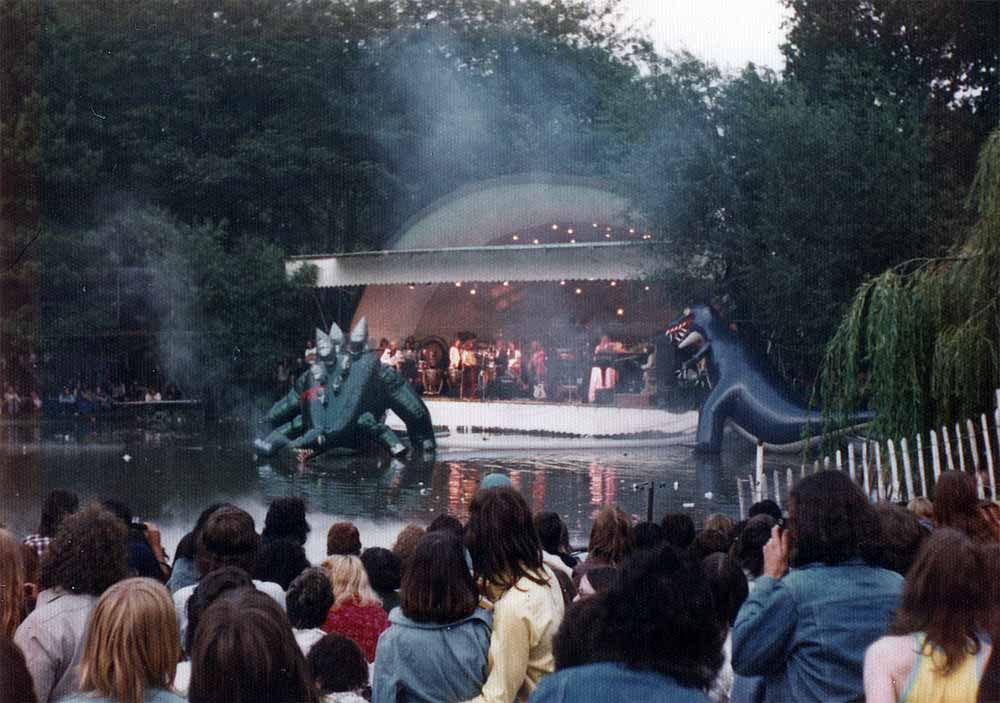
Rick Wakeman is one of the greatest keyboardists in rock music, but more than that, the man is a continual source of hilarious anecdotes. Some of them may be a bit cheeky. This one is downright naughty.
This story takes us back to the days when Wakeman toured his Journey To the Centre of the Earth album. It went all the way to #1 in the UK album charts on 18th May 1974 – Wakeman’s 25th birthday – and he got the phone call with those news just five minutes after he’d called in his resignation from Yes. Suffice to say, it was an emotional day on several levels.
In the period after leaving Yes in 1974 (the first of many times he left that band), Wakeman would launch some of his most ambitious and daring solo projects. These projects were brave and adventurous musically, but he no doubt took bigger chances financially, as he invested in them himself. Several of these risks would pay off, but not all of them. Touring the Journey album was just one of those risks.
Wakeman was keen to bring a certain level of sophistication to the shows. Bearing in mind that mid-1970s levels of technology could only take you so far, he opted for stage props and more static elements that would be easy to manage, could add a lot to the overall atmosphere, and would travel well. This included a gigantic pair of inflatable dinosaurs.
They were made in Holland. One was an ichthyosaurus. The other was a plesiosaur. They were huge! Both of them tipped the scales at several tons and towered well above the 30-foot mark.
Wakeman tells the story about his misbehaving dinosaurs in his 2009 book Grumpy Old Rock Star, commenting on their ginormous size by saying “No point in doing things by halves, I always say. I wish I didn’t always say that, because these dinosaurs cost me a bloody fortune. Still, they looked brilliant.”
This was likely the first time inflatable dinosaurs had been hand-built for a rock gig, and there were practical difficulties to iron out as they went along. For a start, the air pressure inside of them had to be kept at a constant level, or they would quickly begin to deflate, collapse, and lose all their shape. It took a while to fully reinflate them, so maintaining the air pressure was crucial.
The dinosaurs got their debut at the Crystal Palace Garden Party on 27 July 1974. This was a one-date festival line-up with Wakeman headlining over Leo Sayer, Procol Harum, Gryphon, Wally, and, well, the Winkies.
Wakeman did not just appear with a full band, but with the London Symphony Orchestra and the English Chamber Choir, making a huge impression. The setting was gorgeous as well, as the stage in Crystal Palace Gardens faces a small pond, meaning the audience was sitting in a circle in the area around it.
The UK Rock Festivals website features a summary of the day, which among other things say: “Wakeman had put some of the production into two inflatable prehistoric monsters which were supposed to materialize the scene of “the battle” in Jules Vernes’s book. Surprisingly enough the audience reacted positively, accepting it as it was meant to be: humouristically.”

Wakeman remembers: “We placed the dinosaurs beheath the surface of the lake at the front of the stage and when we started to play the song The Battle they inflated, emerging from out of the water, and by carefully controlling the air pumps we could make them move a little and appear to be having a sort of fight. I was playing my keyboards and watching all this – it looked fantastic. It had all gone perfectly to plan until one of the dinosaurs got snagged on something and, unfortunately, sprung a leak.”
The leak was right at the base of its tail, making it very difficult for the crew to carry out repairs. The worst part was that the hole was small, but the air pressure inside was very high, so the creature basically farted its way through the entire performance at a quite serious volume. As the show had been open-air, it didn’t seem to be quite as audible further away from the stage, especially with music playing.
So far so good. The day was a success, which was promising ahead of a plan to continue to tour in America. The crew were at best sceptical at the prospect of hauling the farting dinosaurs with them.
“The crew pleaded with me not to use these inflatable farting dinosaurs,” Wakeman said. “They pointed out the fragility and the difficulty of setting them up, the possibility of them getting destroyed in transit, and also made the perfectly valid point that a fart lost in the ether of an open-air show at Crystal Palace would most likely sound like a nuclear explosion in a smaller enclosed arena gig in the States. I was having none of it. We flight-cased the dinosaurs ready for America.”
Sure enough, there were a few small tears when they got to America, but Wakeman told the guys to patch them up as well they could. This became a repeat maintenance job as they would keep picking up the odd puncture.
As the tour went on, the dinosaur fatigue in the crew was very real, as Wakeman remembers: ”Halfway through the US dates – and after God knows how many giant bicycle tire repair jobs – you could tell that the roadies had had enough. Every night they would lug in the conventional gear and stage set, then you could see they were all avoiding being lumbered with the dinosaur duty. Cue more grumbling all round.”
This routine repeated itself throughout the tour until one night at a show in the Deep South, right in the Bible Belt. Wakeman did his soundcheck, then enquired about the health of the dinosaurs, fully expecting the usual chorus of complaints and moans. To his surprise, he got thumbs up all around. Everything was well. There were no problems.
Wakeman later indicated that he should have known at that moment that something was going on.
The crew did mention that the stage was a little cramped on one side, so both dinosaurs had to be on stage left, but that was not a problem. This was something that had happened before, so Wakeman thought nothing of it.
For the first half of the concert, everything was indeed working perfectly. The dinosaurs emerged just as they should. There were no difficulties with the show on any level. The crowd was loving every minute of the dramatic performance.
…then a plan was set in motion.
Unbeknownst to any of the musicians on the stage, the crew had discovered that by carefully reducing the air pressure in the dinosaurs and then suddenly reinflating them at a rapid rate, they could make it look like the dinosaurs were humping each other very naughtily indeed.
“At first I didn’t notice,” Wakeman said. “I could see the ichthyosaurus was leaning towards the plesiosaur but thought nothing of it and carried on playing. I was right in the middle of a particularly difficult and demanding piece of music when I looked up from my keyboards to see both dinosaurs rampantly humping each other at the front of the stage. Up and down, up and down, while the bemused audience sat in shocked near-silence. The beasts’ humping got faster and faster and more animated until, just before the end of the battle sequence, the plesiosaur let out the most enormous fart and then deflated.”
The story does not say anything about what was said backstage later that night. Wakeman simply added, “The reviews in the Bible-Bashing Belt media the next day were not the best I’ve ever had, let’s put it like that.”
Related article: When Rick Wakeman pushed Salvador Dali off the stage
Related article: When Rick Wakeman ate a curry during a Yes concert

Facebook Comments